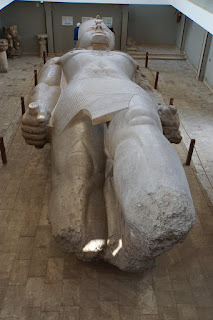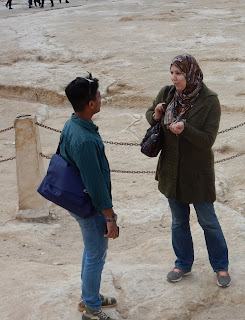Day 3 - Giza
 |
| Step Pyramid |
Our first destination is Saqqara. We pass from the lush green vegetation of irrigated land by the Nile to the utter desolation of the Sahara. I could detect absolutely no vegetation, just sand and rock and dust brown for as far as the eye can see. And there, rising above us, is the Step Pyramid built by the Pharaoh, Djoser, whose statue we'd seen in the museum the previous day. One cannot prepare for either the immensity or the weirdness of it. What would prompt someone to build a pile of rocks to spend eternity under? The exercise would be practiced by only a few more generations of pharaohs, one obviously being the monstrosities in Giza. Pharaohs soon realized that if they didn't want their treasures to be ransacked after their death, they shouldn't be advertising
 |
| King Unas's Tomb unfortunately with our mugs in front |
Suzy directs us to the tomb where King Unas was buried. We're escorted down a series of steps by a guard that Suzy says will allow us to take pictures for about 5 Egyptian pounds. Inside hieroglyphics cover all three sides of the room where the sarcophagus was housed. These are the world's oldest collection of religious texts. Even though I don't understand a single hieroglyph, I take pictures of these, a practice I would continue for the rest of the trip.
 As we drive to our next destination, I notice Egyptians who ride donkeys and drive horses
pulling carts as well as those on tractors and driving cars. Little remains Memphis, once the capital of the world's first great kingdom except a gigantic statue of Ramses II.
Retrieved from a nearby swamp without its feet, it now lies on its back for
the appreciation of buses full of Italians, French and Japanese.
As we drive to our next destination, I notice Egyptians who ride donkeys and drive horses
pulling carts as well as those on tractors and driving cars. Little remains Memphis, once the capital of the world's first great kingdom except a gigantic statue of Ramses II.
Retrieved from a nearby swamp without its feet, it now lies on its back for
the appreciation of buses full of Italians, French and Japanese.On the signs, I read that Ramses liked to post his presence by signing everything with a cartouch many, many times and putting up numerous statues of himself. The granite statue we stand in front is well preserved and the details of his belt and dagger and nipples and easily recognizable. The guy ruled for over 66 years and had over a hundred kids. He really wanted to be remembered.
On the way to Giza, we stop at a papyrus shop. They have lots of paintings similar to those we've already
purchased on display. Our Malaysian friends are told that the listed
price of course isn't the real price. They must negotiate. While Malaysians take seemingly forever to make their choices, we wait outside perched on the front steps, a great he place to watch the
reams of traffic pass by on the busy street.
I watch as dozens of VW vans pass by. I haven't seen these things for decades, not since I was a child and my mother's friend would pick us up to go to the "club" to swim. Here, they seem perfectly designed for public transportation. Their side doors are left open so that passengers can quickly jump in or out without the vehicle coming to a complete stop.
I watch as dozens of VW vans pass by. I haven't seen these things for decades, not since I was a child and my mother's friend would pick us up to go to the "club" to swim. Here, they seem perfectly designed for public transportation. Their side doors are left open so that passengers can quickly jump in or out without the vehicle coming to a complete stop.
 |
| VW Van from my childhood |
We arrive with hordes of tourists at the pyramids of Giza. Three giant pyramids rise above the desert floor. From a distance, their sides appear smooth however proximity reveals they are made of huge stones. One website put the number at 2,300,000 stones weighing two to thirty tons each. I just want to wander around but the brother/sister team want to ride a camel. We go along with the lark which Suzy arranges however we must negotiate our own terms. I understand because Suzy is obviously friendly with the owner. Our introduction included pictures of us holding up the pyramids he took from a crouching position.
 |
| Pyramid tomb entrance |
Suzy drops us off at the guest house Nicola booked for a couple of nights. Our room is crappy room but the view of the pyramids is fantastic. With no beverages on offer, we head to one of the luxury hotels that Nicola read had a good restaurant. Time was a factor so we catch a decrepit taxi to sit with a bunch of business people in lounge that could have been anywhere in the world except the servers are all men.
 |
| Us |
 |
| View from guesthouse |



Comments
Post a Comment